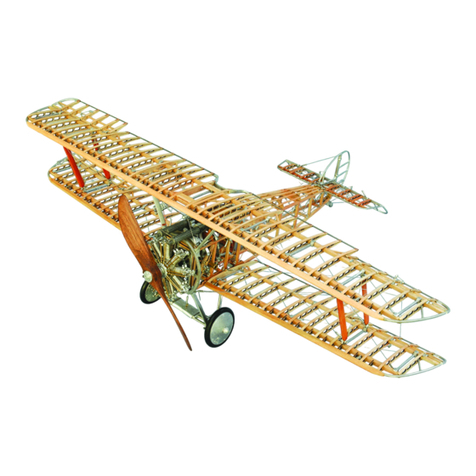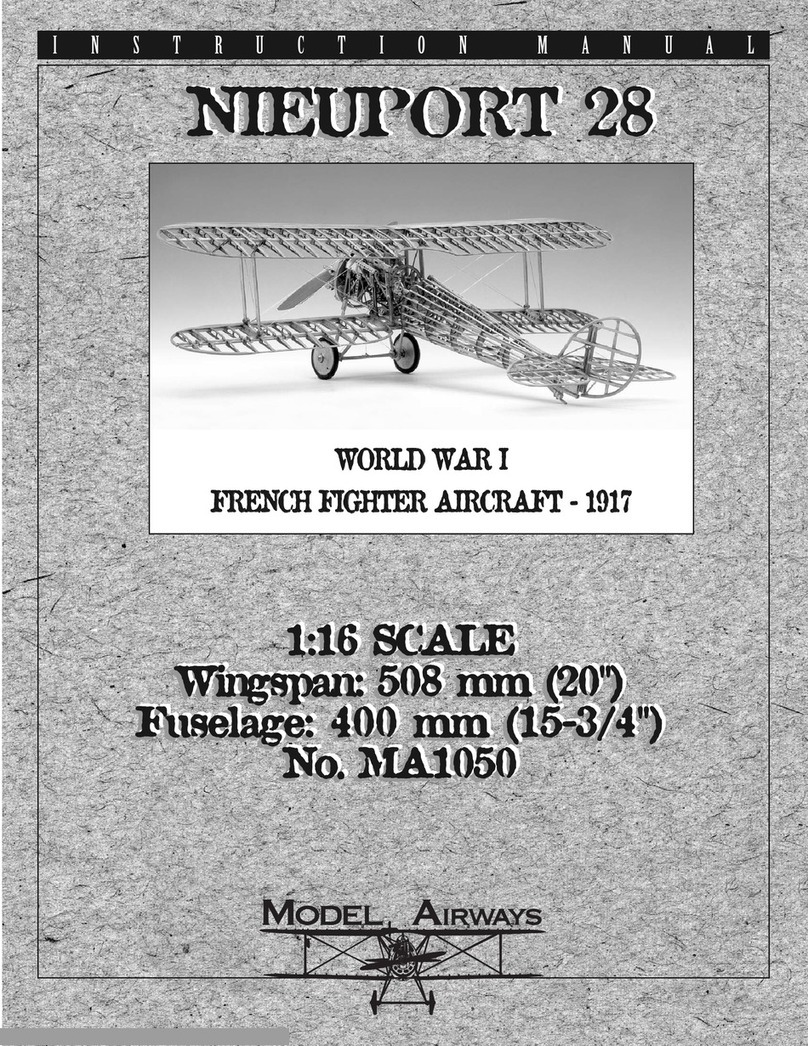
Full Size Model Scale Model Scale
Inches Inches Millimeters
1/4" 1/64" 0.40mm
1/2" 1/32" 0.79mm
3/4" 3/64" 1.19mm
1" 1/16" 1.59mm
1-1/4" 5/64" 1.98mm
1-1/2" 3/32" 2.38mm
1-3/4" 7/64" 2.78mm
2" 1/8" 3.17mm
2-1/4" 9/64" 3.57mm
2-1/2" 5/32" 3.97mm
2-3/4" 11/64" 4.37mm
3" 3/16" 4.76mm
6" 3/8" 9.53mm
9" 9/16" 14.29mm
12" 3/4" 19.05mm
SCALE CONVERSION TABLE
Before You Begin
The
Curtiss JN-4D Jenny
is an interesting
aircraft and makes a splendid model. The
kit is intended as a structural model with-
out any fabric covering. Most every detail of
the real aircraft has been included as model
scale permits. While your model structure
will be glued together, the original real air-
craft had little glue if any. Most of the wood-
en structure was joined with many small
wood screws and metal clips. However,
some of the restored
Jenny’s
now use glue
in addition to the screws, since better glue
is now available.
Britannia, photo-etched metal, and wooden
fittings eliminate creating many parts from
scratch. However, some require final finish-
ing before they are suitable for the model.
This is especially true for the britannia cast-
ings and will be discussed later.
Always complete one construction stage
before moving to the next. When things
go awry, consider doing them over.
Necessary Construction Tools
The following tools and supplies are recom-
mended for the construction process.
Modelers who have built before may have
their own favorites.
A. Knives and Saws
1. Hobby knife with No. 11 blades
2. Razor saw or jeweler’s saw
B. Files
Set of needle files
C. Clamps and Pins
1. Alligator clips (some with and some
without teeth)
2. Wooden clothespins (craft shops have
small versions of the design)
3. Rubber bands
4. Package of straight pins or florist pins
with plastic heads
D. Boring Tools
1. Set of miniature drills
2. Pin vise
E. Miscellaneous
1. T
ack hammer
2. Tweezers (a few)
3. Small fine-pointed scissors
4. Miniature pliers
a. small round
b. flat nose
5. Wire cutters (for cutting steel and
brass or copper wire, rod, and strip
metal)
F. Sandpaper
Fine and medium grit garnet or aluminum
oxide sandpaper (#100 to #220), and
#400 wet-or-dry paper for fittings and
final wood sanding
G. Glue
White glue, Carpenter’s wood glue (yel-
low in color), and Cyanoacrylate glue
(super glue) can be used for most of the
model. Five-minute epoxy provides extra
strength for gluing fittings. The best super
glue for most applications is a medium
viscosity gap-filling type. The watery thin
type is recommended to fill a narrow
crack by capillary action.
H. Power Tools
While not really necessary, one power
tool would be advantageous for this kit.
The kit contains several sizes of steel
music wire that is extremely hard. A
Dremel or other rotary tool fitted with a
small fiberglass-reinforced cut-off wheel
is ideal for cutting off and flattening the
ends of steel music wire.
I. Building Board
A soft but stiff board, such as acoustic
ceiling tile or insulation wallboard, to easily
take straight pins for holding parts during
assembly. This soft board should be
nailed or glued to a hard board so it will be
flat. You can use a table, but a portable
board is good for turning it around to make
the work easier.
Working with the Plans & Parts
Before starting the model, carefully exam-
ine the kit and study the plans. First, deter-
mine if all the listed parts are present.
Handling them will produce a better under-
standing of the kit’s requirements. Try to
visualize how every piece will look on the
completed model. Also, determine the
building sequence – what must be done
first – ahead of time. The instructions will
help, but a thorough knowledge of the plans
at the outset is essential. Be especially
aware of when to rig the many brace wires
in the fuselage. There are a lot of parts that
must be added inside the fuselage. The
brace wires would get in the way if rigged
too soon.
To avoid losing small fittings and hardware,
sort them into labeled boxes or compartments.
These should have lids to keep out dirt.
1. The Plans
Six plan sheets are provided:
1. Laser-Cut Wood Patterns and
Fitting Sketches
2. Upper and Lower Wing Assembly
and Details
3. Basic Fuselage Assembly and Details
4. Tail Surfaces and Landing Gear
Assembly and Details
5. OX-5 Engine and Cockpit Controls
Assembly and Details
6. Component Assembly and Rigging
Details
Model Airways’
Jenny
kit is manufactured
to a scale of 3/4" = 1' 0" (1:16). Each sheet is
drawn to that scale except areas enlarged to
show detail. Most of the enlarged details are
double scale, and designated 2X (1-1/2" =
1'0"). Most dimensions can be lifted directly
off the plans by using draftsman dividers or
a “tick” strip (piece of paper such as an
adding machine roll). Lay the paper strip
over the plan, carefully mark the item’s
length with a sharp pencil, then transfer the
marks to the wood.
Because these are model building plans,
actual measurements were converted to
model inches. For comparison, 1/16" on the
model is equal to 1" on the real aircraft, 1/8"
is 2", and so on. The table below compares
full-size dimensions with scale model inches
and millimeters:
2. Parts
Laser-cut wood parts, photo-etched parts, and
britannia castings are designated by a letter-
number (such as
W1
,
F4
,
R2
) on plans and
sketches. A part noted such as
L2R
or
L2L
would indicate a right or left hand part. You
may also see some similar parts labeled, for
example,
R3A
and
R3B
. Parts are classified
generally in the following letter categories:
C
– CONTROLS: AILERONS, RUDDER,
ELEVATOR
E
– ENGINE, ENGINE PIPING, ENGINE
CONTROLS, RADIATOR, FUEL
TANK, PROPELLER
F
– FUSELAGE
L
– LANDING GEAR, TAIL SKID
R
– RIGGING FITTINGS COMMON TO
VARIOUS LOCATIONS
S
– STABILIZERS, RUDDER, ELEVATOR
W
–WINGS
Wood strips and sheets, rod, wire, tubing,
rigging cord, and similar parts which must
be cut from longer pieces have no letter des-
ignation. Rather, only the dimension of these
items is shown on the plans.
A parts list is included in each of the con-
struction stages, noting the parts required
for that particular stage. A
Master Packaging
Parts List
(separate from these instructions)
is provided that lists the quantities included
in the kit. For wood strips, sheets, rod, wire,
tubing, and rigging, one or several pieces are
provided in the kit as noted on the master
packaging parts list. Each of these have been
assigned a Model Expo (Model Airways) WP
stock part number. These parts must be cut
to length or shape according to the dimen-
sions shown on the plan.
5






























